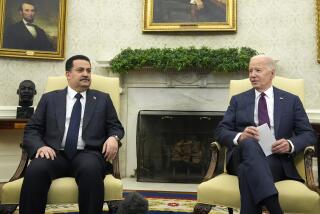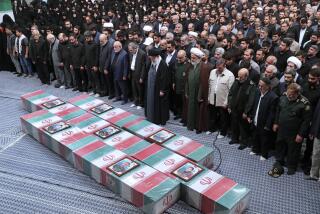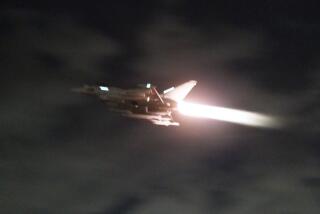U.S. Weighs New Attack as Iraq Repairs Sites
- Share via
WASHINGTON — The Clinton administration is weighing whether to take more punitive measures against Iraq in response to Iraqi President Saddam Hussein’s move to repair missile sites and air defense systems destroyed by U.S. attacks last week.
As many as four Iraqi antiaircraft missile sites are being repaired in defiance of a U.S. warning over the weekend, Pentagon officials said Tuesday. Hussein also has started moving mobile missile sites around in an apparent attempt to lay traps for U.S. pilots patrolling the newly expanded “no-fly” zone over southern Iraq.
“Iraq is forcing our hand,” a senior Pentagon official said. “It’s threatening our pilots. And we can’t tolerate that. We will have to take appropriate measures.”
The options included another round of missile strikes, administration officials said.
Their deliberations came as the CIA and the Pentagon launched a rescue operation in northern Iraq to extricate about 200 Iraqis who worked with the CIA-backed Iraqi National Congress, as well as members of their families and other opposition figures--a total of more than 2,200 people, U.S. and Turkish sources said.
The congress members, including Arabs and Kurds, have been stranded in the rugged northern mountains since the Baghdad-backed Democratic Party of Kurdistan (KDP) began a campaign Aug. 31 to seize control of northern Iraq. The congress, a multiethnic coalition formed with U.S. aid in 1992 that once included the KDP, had its largest base in Kurdistan.
The rescue has been slowed by difficulties in finding places in adjoining Turkey to shelter and feed the stranded Iraqis, as well as to interview them for immigration to the United States. The operation is further hindered because the United States does not know the names or identities of many of those it would rescue and needs to verify their roles in Kurdistan.
Baghdad’s de facto conquest of Iraqi Kurdistan has increased political pressure on the administration as it deliberates what its response to Iraq’s repaired missile sites should be. Washington wants to stop the blitzkrieg that has given the Iraqi leader the greatest single boost at home and in the region since his 1990 invasion of Kuwait.
“Saddam wants to show he’s on a roll--that he has challenged a superpower and can continue to do that,” a U.S. official said.
The United States sent a diplomatic message over the weekend to Iraq warning that it would not allow Baghdad to rebuild surface-to-air missile sites between the 32nd and 33rd parallels, the area covered by the expansion of the southern “no-fly” zone.
Iraqi diplomats at the United Nations and the Iraqi Interest Section in Washington have refused either to accept or respond to communications from U.S. envoys. But the Pentagon official said, “By what they’re doing, we now have an answer. . . . It’s a very threatening and dangerous response.”
U.S. intelligence monitoring indicated Tuesday that Iraqi air defense systems were being repaired with parts from facilities elsewhere in Iraq as well as equipment salvaged from two U.S. missile strikes last week. The goal is thought to be targeting planes enforcing the southern “no-fly” zone, in which Iraqi flights are prohibited.
For the fourth time in five days, Iraq claimed Tuesday to have fired missiles at allied aircraft. The report was flatly denied by the Pentagon, but U.S. officials said it signaled that Hussein was no longer prepared to honor the “no-fly” zones.
“He’s given every indication that he’s inviting another confrontation,” an administration official said.
More to Read
Sign up for Essential California
The most important California stories and recommendations in your inbox every morning.
You may occasionally receive promotional content from the Los Angeles Times.













